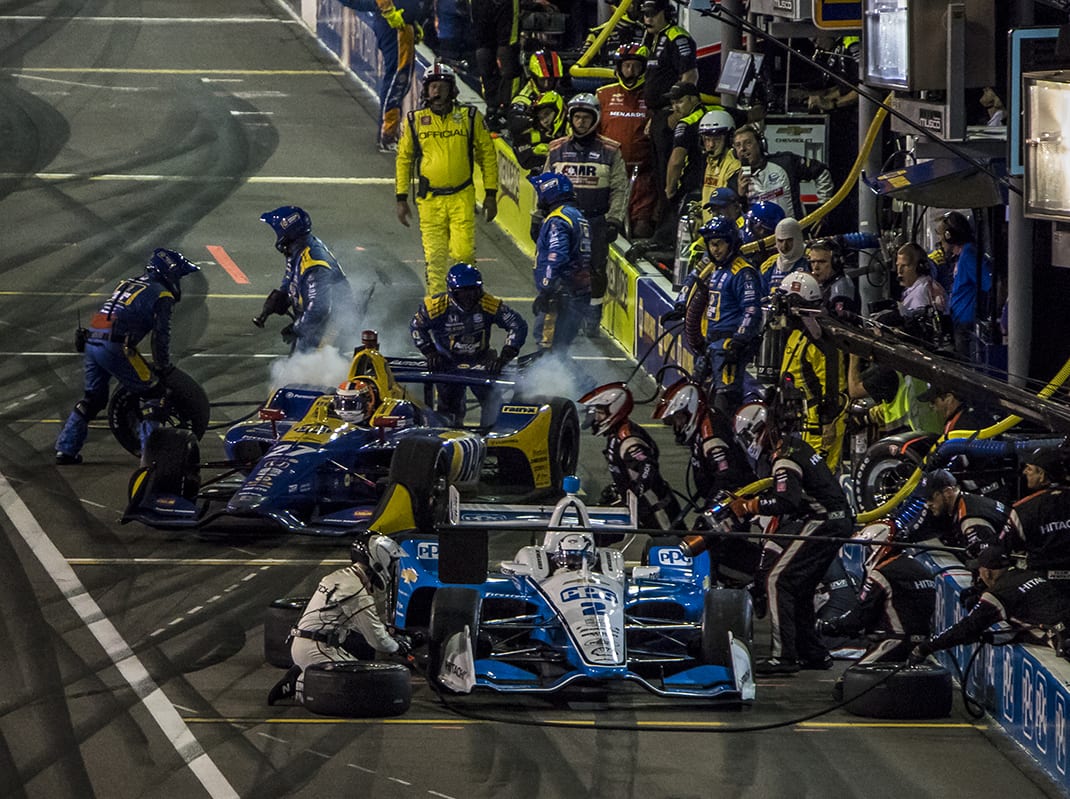Because of deep fields, fairly equal equipment and the incredible reliability of its cars and engines, this may be the most competitive era in Indy car racing history.
Unlike the old days when many of the longer races were decided by attrition, some of today’s NTT IndyCar Series events are run without a caution period and nearly every car that starts the race finishes.
That puts extra emphasis on the pit crew because when drivers at the front of the field are running relatively the same speed, a fast pit stop can be the difference between winning and losing.
Jim Clark’s victory in the 1965 Indianapolis 500 was aided when the Ford Motor Co. brought NASCAR’s famed Wood Brothers Racing team to Indianapolis Motor Speedway to perform the pit stops for Clark and team owner Colin Chapman’s Ford-powered Lotus.
The Wood Brothers crew was the fastest on pit road in NASCAR and brought some of its ideas to the Indy 500, including shortening the fuel hoses so the fuel would run quicker down the gravity fed lines. At that time, the wheels were changed with one wheel nut that was tightened and loosened by a knockoff hammer. The car itself was lifted off the ground by “quick-lift” jack stands.
“Back then, you were worried about trying to shave off a second or two,” explained Team Penske IndyCar General Manager Kyle Moyer. “Now, you are trying to shave off a tenth of a second.
“You are always looking for the edge. You look at wheel guns back when I started in 1980 and they were antiques. Even the air jacks,” Moyer said. “The car itself, the hubs, the way it holds the wheel nut now with the magnets in the splines and everything, you are looking at a tenth of a second. For every tenth of a second, that’s a half a car.
“If you can get two of those, you can pass a car on pit lane.”
Moyer is in charge of all three Team Penske entries in the NTT IndyCar Series and calls race strategy for Indy 500 winner Simon Pagenaud.
To illustrate the importance of pit stops in IndyCar and how they are different than NASCAR and IMSA, let’s focus on Pagenaud’s crew.
Moyer serves as the strategist and works in conjunction with engineer Ben Bretzman on formulating race strategy. Trevor Lacasse is the team’s crew chief and he also changes the outside-front tire. The inside front is changed by Trey Williams with Doug Snyder changing the inside-rear tire and Jeremy Baker handling the outside rear tire. Ben Maser handles the air jack and Eric Crabtree is the fueler. Mike Ford serves as the spotter for the No. 22 Chevrolet.
“It’s a bit different,” Moyer noted. “We can see what NASCAR does because they are in the same building. Because of their 36 weekends, their crew is mainly an on-the-road crew. They work on the cars at the track and maybe a day before they leave.
“In IndyCar, our crew is different. For instance, Pocono to St. Louis, on Monday morning, the actual guys that are here on race weekends are the guys that work on the car at the shop. That’s the biggest difference in some series compared to IndyCar.
“The other part is every single guy on the crew is a mechanic or an engineer,” Moyer added. “They are the guys doing the pit stops as well. A lot of crews bring in guys that do nothing but the pit stops. That’s the difference between us and other series.”
NASCAR teams recruit former college football players and even ex-National Football League players to serve as the over-the-wall pit crew members. They are responsible for pit stops only and most of them do not work on the car as mechanics.
“On the NASCAR side, they are all pit crew guys that train every single day,” Moyer said. “Eighty percent of their job is to be a pit crew guy. On our side, on a normal weekend, we will get 21 seconds of work out of them on pit road and the other 21 hours of work we get out of them working on the car will be as a mechanic.”
As the crew chief, Lacasse has the responsibility of putting the car together with the setup devised by the engineering staff, working with the driver and then putting on the fire suit and helmet and performing his duties on pit road.
“Comparing us to NASCAR, we have to be the shop crew, the road crew, the pit crew and everything else,” Lacasse explained. “NASCAR is a lot more specialized. They are not at the shop, on the road, changing tires. They are either college athletes, ex-NFL, they are working out changing tires. They are pretty big time.”
Click below to continue reading.
